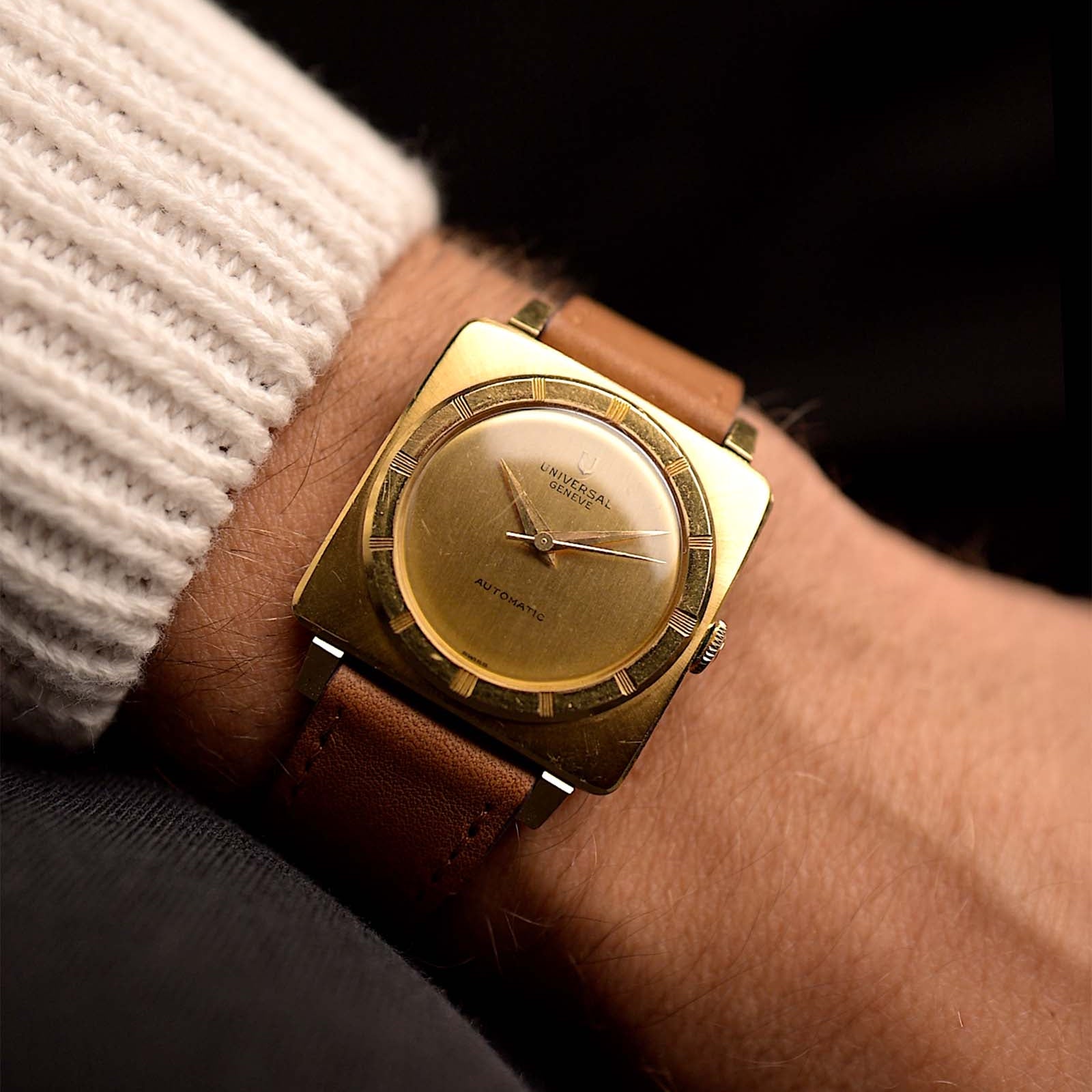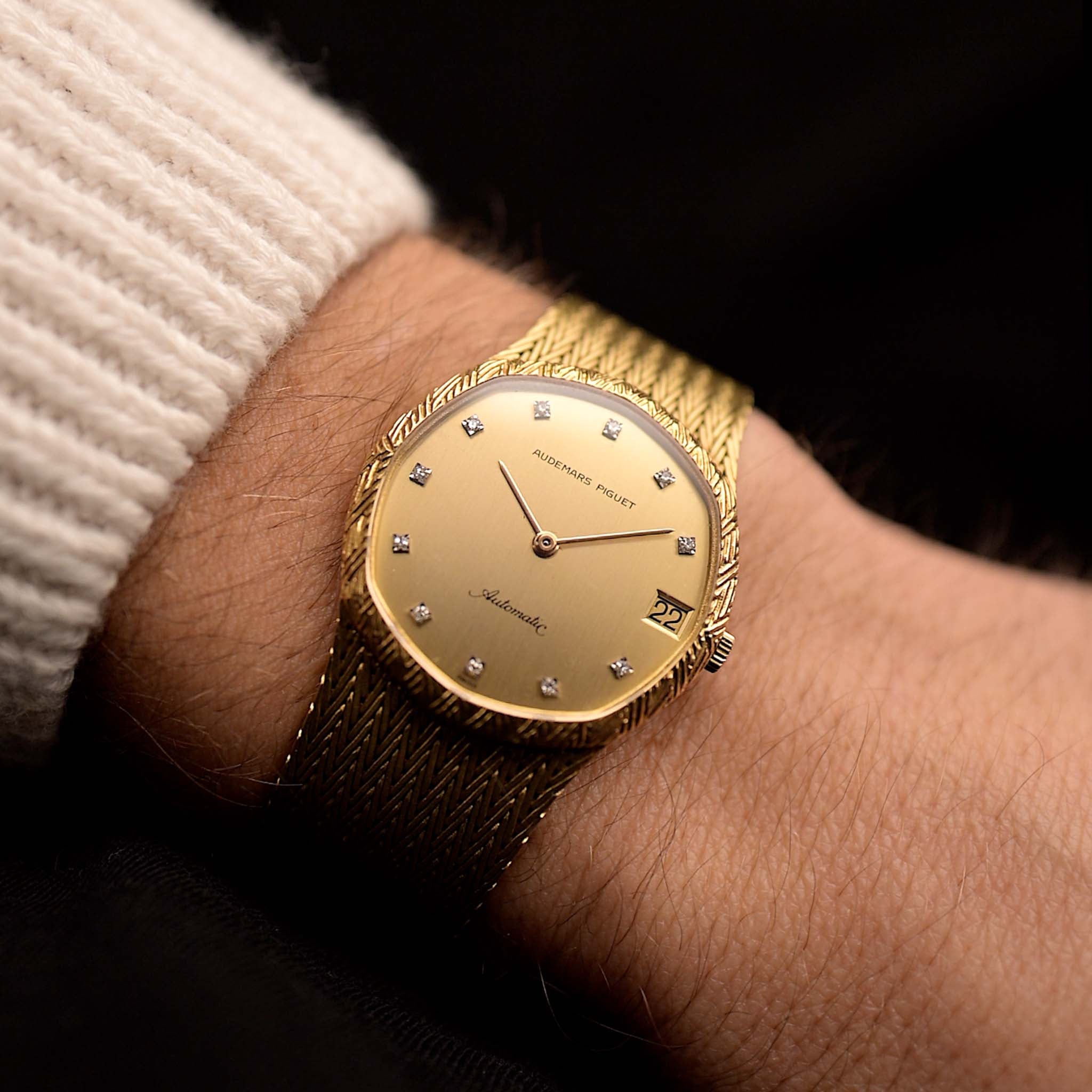One of the funkiest Omega creations of the space age definitely must have been the Chronostop... Certain vintage timepieces stick out of the pack and draw your immediate attention. Sometimes these pieces were just ahead of their time and sometimes they will always stay special. The Chronostop definitely belongs to the latter category. Something completely off the charts. If you think late 1960s watch design, you might think of colorful, shaped, kinda quirky chronographs... and Omega said Yes! The Chronostop definitely embraces all of these characteristics to the fullest!
January 24, 2023
Omega Chronostop Reference Guide - The Monopusher Chronograph

Marcus Siems @siemswatches
Collector, Author, Data Analyst
That late 60s Watch Certain vintage timepieces stick out of the pack and draw your immediate attention. Sometimes these pieces were just ahead of their time and sometimes they will always stay special. Omega's Chronostop is definitely the latter of the two and something completely off the charts. If you think late 1960s watch design, you might think of colorful, shaped, kinda quirky chronographs... but the Chronostop said YES, to all of the above!
Among (vintage) watch enthusiasts the Chronostop probably is one of the most recognizable timepieces. It also is a design most encapsulating its time of production, the late 1960s. But I guess still a lot of people don't really know what to make out of this piece... So we want to bring this underdog chronograph a little closer to you and show what makes this piece so cool, so out-of-the-box.
 The classic Chronostop layout: Three-hand chronograph with an orange 60-second chronograph hand, crown at 4o'clock, pusher at 2o'clock, luminous index hands and stick hour marker. Photo @goldammer.me.
The classic Chronostop layout: Three-hand chronograph with an orange 60-second chronograph hand, crown at 4o'clock, pusher at 2o'clock, luminous index hands and stick hour marker. Photo @goldammer.me.
1) History & Design
Basics. The history of the Chronostop begins in 1966[1-3]. Around that time Omega introduced their stripped chronograph with a sole 60-seconds central chronograph hand in orange ... and no other sub-dials. Effectively, a Chronostop can thus only time very short time-intervals - well up to 60 seconds, or you'd have to count the laps yourself.
Dial. Most typically you'll see that a Chronostop is not only highly peculiar in its functionality but can also be a bit flashy in its color choices. Back then these pieces came in all shades of color from blue, red, green, to white grey and black, and all the in betweens as well as even two-toned. But you'll also observe different dial "shapes" as they might either be flat or convex - like an inverted pie-pan dial.
 Compare the two dials: On the left you can see a convex "inverted pie-pan" dial and on the right a flat dial. Photo @goldammer.me.
Compare the two dials: On the left you can see a convex "inverted pie-pan" dial and on the right a flat dial. Photo @goldammer.me.
Case. Compatible with the funkiness of this collection, and the chronograph landscape as a whole[4], the Chronostop of course couldn't just simply be round. The pieces most prominently rather featured a cushion or oval shaped case in steel (only a very limited number of pieces were produced in gold-capped steel and I'm not aware of any full-gold pieces). The crown and pusher were located at 4o'clock and 2o'clock, respectively.
2) Movements
Movement. Generally, Omega introduced two new manually-wound movements for their Chronostop collection. Two calibers that were solely used in these simplified chronographs. The calibers 865 (no-date) and 920 (date) were introduced in 1966 and 1968, respectively[1-3]. As the chronograph only needed a stop-second hand these movements were simplified versions of the base caliber 860, Omegas work-horse chronograph movement of the time. Interestingly, to time an event you had to push to start the chronograph-hand, push down and hold it to read the elapsed time and release the pusher to reset to zero.
 A chronograph module always adds some complexity to the movement architecture. But, as you can see here, the caliber 865 is truly a very simplified chronograph. Photo @goldammer.me.
A chronograph module always adds some complexity to the movement architecture. But, as you can see here, the caliber 865 is truly a very simplified chronograph. Photo @goldammer.me.
Production. The calibers 860 and 920 were in production for only a time-span of about 4 years. Until 1970 Omega produced roughly about 185,000 units - 124,000 865s and another 61,000 920s. Meaning that for both of these movements the yearly production was at around 30,000[1-3].
3) Variations
| Ref. | Caliber | Line | Depth Rating | Bezel | Diameter |
|---|---|---|---|---|---|
| 145.007 | 865 (no-Date) | Seamaster | 60m | fixed tachy, pulso, diver | 41mm |
| 145.008 | 865 (no-Date) | Seamaster | 60m | rotatable diver | 41mm |
| 145.009 | 865 (no-Date) | Geneve | 30m | fixed 1/5 sec. | 35mm |
| 146.009 | 920 (Date) | Geneve | 30m | fixed 1/5 sec. | 35mm |
| 145.010 Driver | 865 (no-Date) | Geneve | 30m | fixed 1/5 sec. | 35mm |
| 146.010 Driver | 920 (Date) | Geneve | 30m | fixed 1/5 sec. | 35mm |
| 146.012 UFO | 920 (Date) | Geneve | 30m | fixed 1/5 sec. | 41mm |
Table 1. Chronostop references with their core features.
Well, I've shown you the classic Chronostop reference (145.009 & 146.009) thus far but this classic came with a few twists as well. I'd define the default option as the Geneve version with standard dial orientation and an oval case (xxx.009). But other iterations came in the Seamaster lineup, as the "Driver" configuration, and an Italian market reference. So let's find out how these references branch out.
 Figure 1. Lineup of the Omega Chronostop variations (7 references). Including 4x Caliber 865 (no-Date, bottom) and 3x Caliber 920 (Date, top) references. Two of which are from the Seamaster collection (145.007/8). Another two share the so-called "Driver" configuration, i.e. 90 degree rotated dial layout (xxx.010). Photos Courtesy of Christie's, Sotheby's, Brandizzi, ObsessedByWatches, Kronos360 & @goldammer.me.
Figure 1. Lineup of the Omega Chronostop variations (7 references). Including 4x Caliber 865 (no-Date, bottom) and 3x Caliber 920 (Date, top) references. Two of which are from the Seamaster collection (145.007/8). Another two share the so-called "Driver" configuration, i.e. 90 degree rotated dial layout (xxx.010). Photos Courtesy of Christie's, Sotheby's, Brandizzi, ObsessedByWatches, Kronos360 & @goldammer.me.
3.1 The Seamaster. Initially, the Chronostop started as part of the Seamaster lineup back in 1966. Seamaster Chronostops thus have an increased depth-rating of 60m (6ATM, in comparison to 30m) in a quite different case-design (C-shape). But that's not the only difference. The dial layout and functionality was quite different: Those pieces featured functional bezels (tachymeter, telemeter, pulsometer, countdown) inside the crystal. To put the cherry on top the ref. 145.008 even came with a rotational bezel! So overall not as reduced as the slightly later Geneve collections.
 The Seamaster Chronostop with internal pulsometer bezel and a C-shape case design. Photo courtesy of SubDial.
The Seamaster Chronostop with internal pulsometer bezel and a C-shape case design. Photo courtesy of SubDial.
3.2 The Driver. Well if you thought it couldn't get much quirkier let me introduce you to the xxx.010 references, aka "The Driver". It was supposed to be the ultimate car-watch. Omega's idea was to rotate the full dial by 90 degrees and advertise that you should wear it under your wrist. In this way, when you hold the steering wheel you'd be able to perfectly see the time on your wrist. What a marvel!
 Advertised as "Introducing the under-the-wrist start-and-stop watch: Omega Chronostop" the dash-board instrument itself under your own wrist. Photo of a 145.010, Courtesy of ObsessedByWatches.
Advertised as "Introducing the under-the-wrist start-and-stop watch: Omega Chronostop" the dash-board instrument itself under your own wrist. Photo of a 145.010, Courtesy of ObsessedByWatches.
3.3 The Dynamic. During the 1960s and 70s Omega has really been experimenting a lot with case-shapes, particularly making the wrist experience more ergonomic (see also "The Driver"). Another collection that tried to optimize this aspect was the "Dynamic", a new collection with its own bracelet system and looks[5]. This principle spilled over into other projects and lines and thus a cross-over between the Dynamic and the Chronostop was born.
The Dynamic Chronostop - aka the UFO, aka "the Italian" - featured an almost perfectly round case construction, with a broad bezel and the aforementioned integrated bracelet system and was intended for the Italian market[1]. Beside the pusher at 2o'clock you wouldn't necessarily associate this piece with a chronograph. But it exists and potentially loved by Omega's Italian clientele?
 I promised you it'll be a fun reference guide. An otherworldly Omega 146.012 chronograph - the Dynamic Chronostop. Photo Courtesy of Christie's.
I promised you it'll be a fun reference guide. An otherworldly Omega 146.012 chronograph - the Dynamic Chronostop. Photo Courtesy of Christie's.
4) Conclusion
The Chronostop truly is a chamber of oddities, but only charming ones (imho). I promised you the Chronostop is one of Omega's, well the watch world's, most fun project of the last Century.
Today, we might consider these pieces odd, funky, even clumsy, but they were built on a very simple and timeless basic principle: "have the most suitable and functional timepiece as possible". If you want, the Chronostop is the space-age update to the Bauhaus credo.
 It does look pretty darn cool... and with the red-orange accents you can easily combine the Chronostop with a myriad of different attire option. Photo Courtesy of SubDial.
It does look pretty darn cool... and with the red-orange accents you can easily combine the Chronostop with a myriad of different attire option. Photo Courtesy of SubDial.
If we're honest, the short production run and the rather limited target group indicate that the Chronostop at its time wasn't really a massive success for Omega. But don't we all love our underdog watches, the pieces that otherwise might stay overlooked?
Look at it this way: The Chronostop is a watch that's been out of production for over 50 years now, featured tons of different dial (and even case) variations and been produced "only" 185,000 times (that's still a lot less than Rolex Submariners in our decade alone...) you probably won't find someone with the same piece unless you're explicitly looking for one. So let's take it as it is: a super fun timepiece!
You can find our full list of reference guides - Here
References
[1] An Overview of Omega Chronostop Wrist Watches; Steve Waddington, Old-Omegas;
http://www.old-omegas.com/chronostop.html
[2] Omega Chronostop - an undervalued single pusher chronograph?; Felix Goldammer, Goldammer Vintage Watches;
https://www.youtube.com/watch?v=CjMDYer7Ubs
[3] The Omega Chronostop; Dan Henry;
https://danhenrywatches.com/blogs/journal/the-omega-chronostop
[4] The Modern History of Watch Case Making; Marcus Siems, Goldammer Vintage Watches;
https://goldammer.me/blogs/articles/watch-case-guide
[5] Omega Geneve Dynamic watches from the 1970s; Balazs Ferenczi, Fratello;
https://www.fratellowatches.com/omega-geneve-dynamic-watches-from-the-1970s/
All rights on text and graphics reserved to the Author.




























2 comments
I bought mine in 1970 in Holland, according to the serial number it was produced in 1969. It has a classic steel bracelet, I unfortunately lost the classical red box. But I understood later that they came with the special Mexico Olympic Games box. Did the watchseller exchanged them?
Thanks for this nice reference about the Omega Chronostop. I have the Driver version with no date function. The original strap that my watch had was a red leather band with a signed overcenter clasp like that of a metal strap. Unfortunately, the leather has deteriorated but I still have it.
Leave a comment